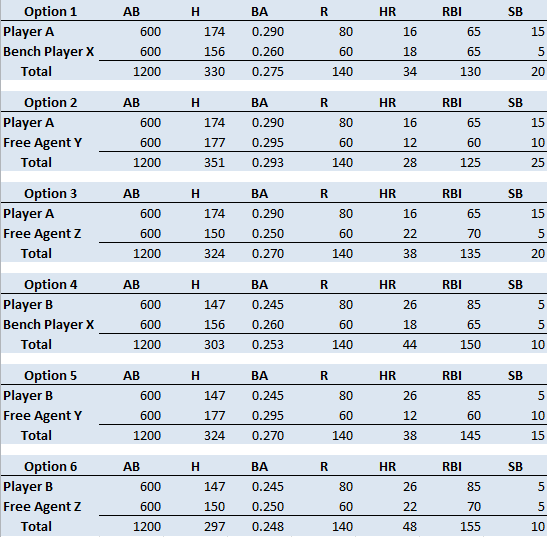You are in the middle of the pack in the league standings, with your biggest opportunity to gain rotisserie points being in HR and RBI. Your other offensive categories are solid, but you recognize that the batting average category is tightly contested. If your team batting average were to drop a few points it would cause you to plummet in the category.
You have received this trade offer:
You Give Player A: projected for .290 BA, 80 R, 16 HR, 65 RBI, 15 SB
You Get Player B: projected for .245 BA, 80 R, 26 HR, 85 RBI, 5 SB
Trades like this are difficult to evaluate. Are the additional 10 HR and 20 RBI worth the 45 point decline in BA?
The proposed deal looks great from a HR and RBI perspective. But you have concerns about the batting average aspect. You believe the points you will gain in HR and RBI will be canceled out by the loss in batting average.
So you reject the deal.
Framing
Enter the concept of framing, or the lens through which you view and evaluate decisions. In the scenario above, this decision was made strictly under the assumption that this was a one-for-one trade.
While the offer was a one-for-one trade, you should not treat it that way. This is a narrow point of view. Your decision making can improve dramatically if you widen your frame.
Back To The Example
It’s short sighted to believe that this would be the only transaction you would make to solve your HR and RBI problem. Whether you accept this trade offer or not, your next step is probably to evaluate your bench players against the free agent list and take action there to add HR and RBI potential or to protect yourself in BA.
You’re not going to cut Player A. It will be someone else on the chopping block. Someone like Bench Player X.
Bench Player X: projected for .260, 60 R, 18 HR, 65 RBI, 5 SB
And let’s assume there are two interesting free agent candidates available:
Free Agent Y: projected for .295, 60 R, 12 HR, 60 RBI, 10 SB
Free Agent Z: projected for .250, 65 R, 22 HR, 65 RBI, 5 SB
Player X (and the free agents) should be included in your analysis of the trade. Widen your decision making frame.
Instead of just a straight up trade of Player A for Player B, widening the view to include the bench player dramatically increases the options before you. Now you can choose one of these options:
Keeping in mind that HR and RBI are the goal and a decrease in batting average could lead to a significant decrease in points, Option 5 seems very intriguing. The batting average of the players involved does drop from .275 to .270 for the acquired players, but HR increase by four and RBI by 15.
Wider Frame… Better Decisions… Optimal Outcomes
The potential downside of widening your decision making frame is that the alternatives to choose from increase exponentially as you add more options. But if you do take a step back and follow this approach, you should find the following to be true:
- You will make better choices. It’s very difficult to see the combined effect on your team when you try to make decisions in isolation. It is very difficult to understand the full ramifications of trading Player A for Player B. But knowing that your main concern is to add HR and RBI without sacrificing batting average, the optimal decision becomes clear.
- You will find it easier to make decisions. It’s much easier to choose when you can see that a clearly superior option exists.
- You will feel better about the decisions you make. You have to! You know you’re making the right choice. No more feelings of guilt and second thoughts after making a trade.
Another Consideration
If you’re an avid SFBB reader you may be familiar with the concept of arbitrage, or making several small incremental gains over a series of trades/transactions that ultimately add up into significant benefit. With arbitrage in mind, the offer is not only evaluated as Player A for Player B, but would also consider what Player B could turn around and be exchanged for. Could another small incremental gain be had by turning around and trading Player B?
Summary
Decisions do not have to be black or white. They shouldn’t be this or that. If you are struggling to make a decision, take a step back and widen the frame of your decision making. Give yourself more options and choose the best course of action from those multiple options.
Stay smart.
